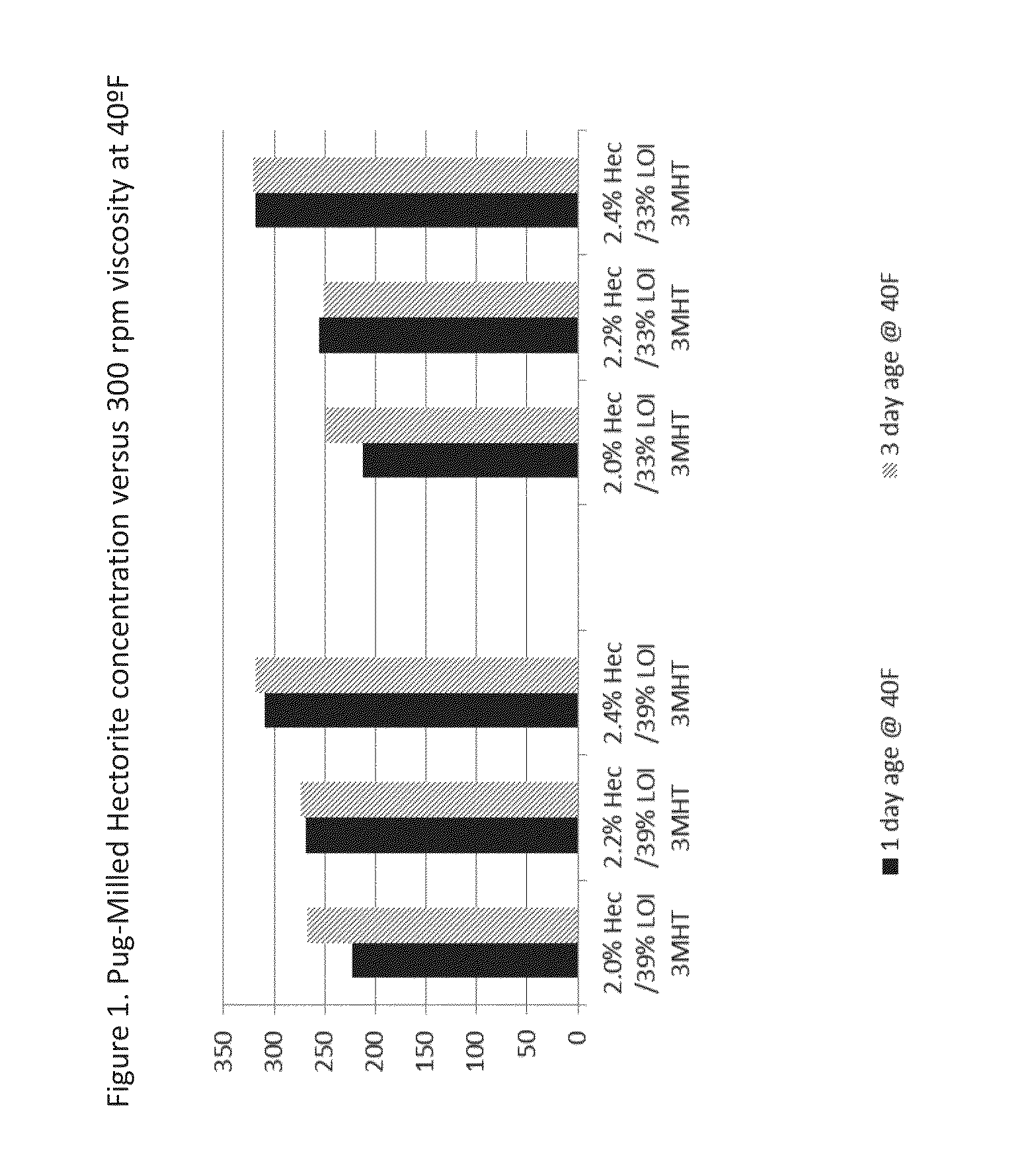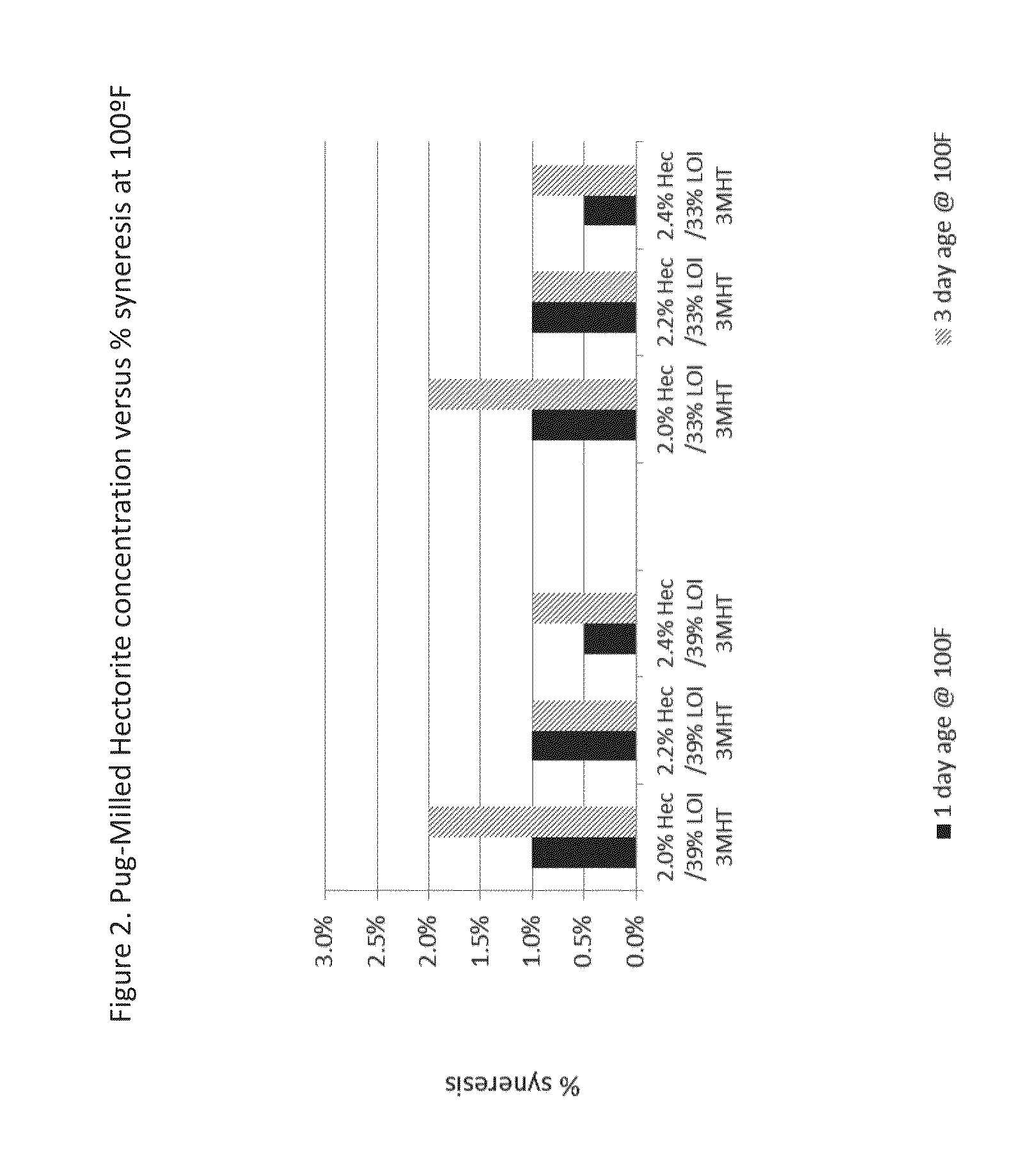Slurry concentrate and associated methods of use
a technology of slurry concentrate and associated methods, which is applied in the direction of sealing/packing, chemistry apparatus and processes, and well accessories, etc., can solve the problems of safety hazards for workers handling such additives, and achieve the effect of improving the stability and viscosity of slurry concentra
- Summary
- Abstract
- Description
- Claims
- Application Information
AI Technical Summary
Benefits of technology
Problems solved by technology
Method used
Image
Examples
example 1
[0029]Example 1 illustrates the results obtained from a slurry concentrate prepared according to the present invention. The organoclays were prepared by first placing 85.7 g of 3 MHT in an oven at 65° C. At the same time, 107.9 g of hectorite clay was placed in a bakers tray and warmed in the oven. When the 3 MHT became molten, the 3 MHT and clay were both removed from the oven and the amine was poured onto the clay. The resulting organoclay was hand dispersed with a spatula for 5 minutes. The organoclay was then ground through a hand-turned meat grinder (3 passes). This ground organoclay was then dried in a forced hot air oven at 105° C. for approximately 16 hrs. The dried organoclay was milled using a Brinkman mill (0.5 micron mesh screen, 1 pass). The milled, dried organoclay was used to prepare guar slurries.
[0030]Guar slurries were prepared by charging materials to a 1 L stainless steel beaker using an overhead stirring motor equipped with a 4-paddle, 2.5 cm×1.0 cm stirring bla...
example 2
[0032]Example 2 illustrates the results obtained from a slurry concentrate prepared according to the present invention. The organoclays were prepared by first placing 85.7 g of 3 MHT in an oven at 65° C. At the same time, 107.9 g hectorite clay was added to tap water in a stainless steel reactor, using sufficient tap water to produce a slurry containing 5% by weight of hectorite clay. The stainless steel reactor was equipped with an overhead stirrer and thermal controller. The slurry was warmed to 65° C. When the 3 MHT became molten and the slurry reached temperature, the 3 MHT was charged to the hectorite clay slurry and mixed for 1 hour in the stainless steel reactor. After 1 hour, the organoclay mixture was filtered. The collected organoclay was dried for approximately 16 hours in a forced hot air oven at 105° C. The dried organoclay was milled using a Brinkman mill (0.5 micron mesh screen, 1 pass). The milled, dried organoclay was used to prepare guar slurries.
[0033]Slurry conce...
example 3
[0035]Example 3 illustrates the results obtained from a slurry concentrate prepared according to the present invention in comparison to a previous slurry concentrate of Example 2. The additives were prepared as described in Examples 1 and 2 above. A control sample using an organoclay prepared from bentonite and methyl benzyl dihydrogenated tallow quaternary ammonium salt (2 M 2 HT) was prepared. The procedure described in example 2 was used to evaluate the slurry concentrate. For the particular lot of guar used in this example, the concentration of bentonite / 2 M 2 HT organoclay in the formulation to achieve the target parameters was 2.4 wt. %. This achieved an average viscosity of 260 cP at 300 rpm at 40° F., and a syneresis after 3 days at 100° F. of 1%. The control slurry concentrate was compared to the slurry concentrates prepared in Examples 1 and 2.
[0036]The results of the comparison are summarized in FIG. 5. The slurry concentrates, prepared according to the present invention,...
PUM
| Property | Measurement | Unit |
|---|---|---|
| viscosity | aaaaa | aaaaa |
| viscosity | aaaaa | aaaaa |
| weight % | aaaaa | aaaaa |
Abstract
Description
Claims
Application Information
 Login to View More
Login to View More - R&D
- Intellectual Property
- Life Sciences
- Materials
- Tech Scout
- Unparalleled Data Quality
- Higher Quality Content
- 60% Fewer Hallucinations
Browse by: Latest US Patents, China's latest patents, Technical Efficacy Thesaurus, Application Domain, Technology Topic, Popular Technical Reports.
© 2025 PatSnap. All rights reserved.Legal|Privacy policy|Modern Slavery Act Transparency Statement|Sitemap|About US| Contact US: help@patsnap.com



